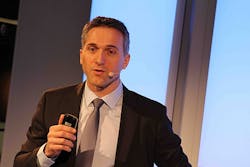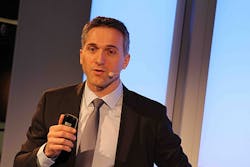The travails of the world's largest lighting company mark the industry's second big reminder this week that hurdles remain on the road to becoming an IoT and data company.
Philips Lighting reported a 16.5% drop in adjusted first quarter earnings and 67% plunge in net income on an 11.2% sales decline, delivering the industry's second reminder this week that lighting's biggest ever transformation ever is no free ride.
Interested in articles & announcements on LED lighting business updates?
The world's largest lighting company said that “adjusted EBITA” for the quarter ended March 31 tumbled to €106 million from €127 million in the same quarter a year ago as sales fell to €1.5 billion from €1.69 billion. The earnings fall was far more precipitous from a net income perspective, which plummeted to €20 million from €61 million. Straight up EBIT (income from operations) dove by 58.2% to €39 million from €94 million, and EBITA before adjustment sunk by 48.9%, to €62 million from €122 million. Philips focused attention on the most forgiving of the drop-offs, the 16.5% slide in adjusted EBITA, which a spokesperson told LEDs Magazine “best reflects what's going on.”
No matter which measure you prefer, the drop came two days after the world's second largest lighting company, Osram, cut its 2018 sales and earnings forecast.
Both companies, and the industry as a whole, are undergoing a major shift from selling conventional lighting to providing Internet-connected LED lighting systems that give users greater control and that turn lighting systems into data collection networks. Philips itself has epitomized the attempt to morph into an IT era identity, as it will soon change its name to “Signify,” and as it recently launched a wide ranging Internet of Things (IoT) data collection and analysis scheme called Interact.
But Philips and the industry are struggling with the costs associated with the transformation, and with finding the right business model, which many people believe will entail selling lighting as a service as well as monetizing the data gathered by the intelligent systems.
“Our focus remains on implementing our strategy toward the shift to LED, systems and services,” said Philips Lighting CEO Eric Rondolat. (Photo credit: Mark Halper.)
On the brighter side, unlike Osram, Philips held steady on its outlook for the year, noting that ongoing cost cutting (the company incurred €39 million in first-quarter restructuring charges) and other measures will help.
“We aim to improve our adjusted EBITA margin from 9.6% to 10.0–10.5%,” Philips Lighting CEO Eric Rondolat said. “We will continue to focus on our cost reduction initiatives, and expect to benefit from higher savings as of the second half of 2018. We also aim to deliver positive comparable sales growth for the full year on the basis of a strong second half. We expect to generate solid free cash flow in 2018, which is, however, expected to be somewhat lower than the level in 2017 due to higher restructuring payments.”
Philips also pointed out that LED price erosion is slowing down.
The currency factor
For the first quarter, Philips toned down the 11.5% general drop-off in sales by pointing out that “comparable sales” declined by only 3.5%, although Philips' definition of “comparable” comes mostly from adjusting unfavorable currency exchange rates back into Philips' favor. The Eindhoven, Holland-based company implicated the dollar, China's renminbi, India's rupee, Indonesia's rupiah, and Argentina's peso. Osram cited the declining dollar versus the euro as a major factor in its financial warning earlier this week.
Philips blamed much of the first-quarter decline on sluggishness in its Home segment, which primarily sells Philips' Hue smart lighting line that allows users to dial up different light settings including color and CCT, and to use smartphone and other Internet-connected controls. As LEDs Magazine has reported, Philips has been boosting Hue's capabilities, adding outdoor offerings, providing wall switches for those who'd rather not use smartphones and other modern devices as light controls, making Hue more interactive, and linking Hue into hardware from leading games hardware firm Razr.
But the efforts have yet to pay off on the bottom line. The segment suffered a €22 million loss in EBIT (income from operations). Sales fell to €92 million from €106 million in the same quarter a year earlier, representing a raw decline of 13.3%, or a decline of 6.4% when adjusted for currency fluctuations (Philips’ so-called “comparable sales.”)
“The first quarter marks a soft start to the year, mainly due to a weak performance in Home, most notably in the United States,” CEO Rondolat said.
Philips fared much better in its Professional group, which sells lighting and services to commercial and government users, and which is now Philips’ largest business segment. Professional registered a 7% gain in EBIT, to €7 million, up from a loss last year of €15 million. The profit was slim — barely 1% — compared to the €593 million in sales the group racked up. And the sales volume itself fell, from €621 million in the same quarter a year ago, marking a straight-up 4.5% decline, although Philips pointed out that sales actually gained 3.2% when adjusted for currency.
The segment that sells LED lamps, tubes, drivers, and modules to consumers and commercial buyers — the segment is called “LED” — also showed a modest sales growth when adjusted for currency fluctuations. Actual revenue fell to €444 million from €468 million, for a straight decline of 5.1% but a currency-adjusted increase of 3.6%. Income from operations was relatively flat, dipping slightly to €41 million from €42 million in the first quarter of 2017.
The conventional Lamps business continued to shrink, although it remains far larger than the struggling, newfangled, Hue-oriented €92 million Home division. Revenue in conventional lamps was €370 million, down from €490 million a year ago. Income from operations fell by 43%, to €62 million from €108 million.
Optimism
Outside of the Home segment, CEO Rondolat noted, “Our other three businesses further improved their operational profitability, particularly Professional which increased its adjusted EBITA margin by 310 basis points. I am pleased with the progress made on the cost side with a 13% reduction in our indirect cost base, and with our free cash flow performance after a strong fourth quarter. Our focus remains on implementing our strategy toward the shift to LED, systems, and services.”
Philips Lighting has certainly been busy embracing the new IoT ethos. In addition to changing its name and launching Interact, its first quarter bustled with wins and new projects, the Hue additions, an outdoor smart lighting job with Huntington Beach, CA,the hiring of an IT networking veteran from Cisco to run the Americas division, trialing Li-Fi in Paris, installing Power over Ethernet at a small modern office in Copenhagen, and figuring out how to grow rosier roses.
It also continues to pioneer innovative lighting applications, such as human-centric lighting intended to improve health and productivity at an office building in Prague and at Oslo Airport.
But as Philips' first-quarter results demonstrate, these things all cost money. Although Philips had three months ago reported a modestly upbeat set of financials for 2017 and the fourth quarter, today's results served a reminder that the path to IoT lighting still has hurdles. The challenge is driving one of the industry's longtime major players, GE, out of the business entirely (GE recently started its exit by selling European and other lighting operations) and it also triggered a profits warning from Zumtobel earlier this year.
The shift to LED technology was in its own right the biggest transition that the lighting industry had ever seen, after more than a century of tungsten and other conventional light sources. But that has now happened. Many, but certainly not all, companies, managed to survive the Great LED Upheaval, Act One.
Act Two is proving to be equally if not more tumultuous. It is a metamorphosis of business models, as the caterpillars of hardware vendors can no longer survive in an era when LED light sources last far longer than preceding technologies. Some will wither in the cocoon, some will get eaten — perhaps by IT companies. Some will emerge as butterflies feeding on services and the IoT. Even then, some will flutter. Others will soar.
Who would want to be a lighting company today?
MARK HALPERis a contributing editor for LEDs Magazine, and an energy, technology, and business journalist ([email protected]).






